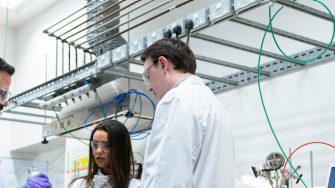
Our research is about fundamental fluid flow, turbulence, combustion, thermodynamics, and heat transfer, which are crucial to tackle a wide variety of engineering problems in power and energy systems. We have well-established research in engines, optical diagnostics, computational simulation and fire safety at both system and scientific levels.
Power and energy efficieny
We perform optical and laser-based imaging in optically accessible engines and high-pressure chambers to understand complex and transient motion of in-cylinder flows, development of flames, and formation process of pollutants. The measurements enable scientific findings for both higher efficiency and lower emission engines, which are applicable to electrified cars, unmanned aerial vehicles, power generators and marine propulsion systems. We also perform systematic engine testing and thermodynamic analysis to enhance the use of renewable fuels such as hydrogen, ethanol, methanol and biodiesel.
Clean combustion
Advanced optical and laser-based combustion diagnostics are performed in fundamental flames to help develop clean burning, high efficiency combustors while supporting the high fidelity modelling effort. We conduct computational multi-scale modelling of multi-physics turbulent flows in relation to clean combustion and renewable fuels. We work with several advanced models, including direct numerical simulations (DNS), which is performed on massively parallel supercomputers, large eddy simulations (LES), and transported probability density function methods performed on large cluster computers. The modelling work is closely coupled with the experimental efforts on fundamental flames and combustion in engines.
Fire safety
We develop innovative fire suppression systems and practical fire control strategies, and Investigate how the evacuation of people in the event of building fire is affected by the human behavioural response to a fire situation subject to the burning of lightweight materials. Novel strategies are used to combine nano-particle with existing flame retardants through nano-filler technology, and multi-scale computational models are applied to capture the flammability properties, thermal degradation, and combustion characteristics of advanced lightweight materials and structures. The new research outcomes lead to new fire tests and standards to ensure that more robust fire safety provisions are provided for advanced materials and applications.







